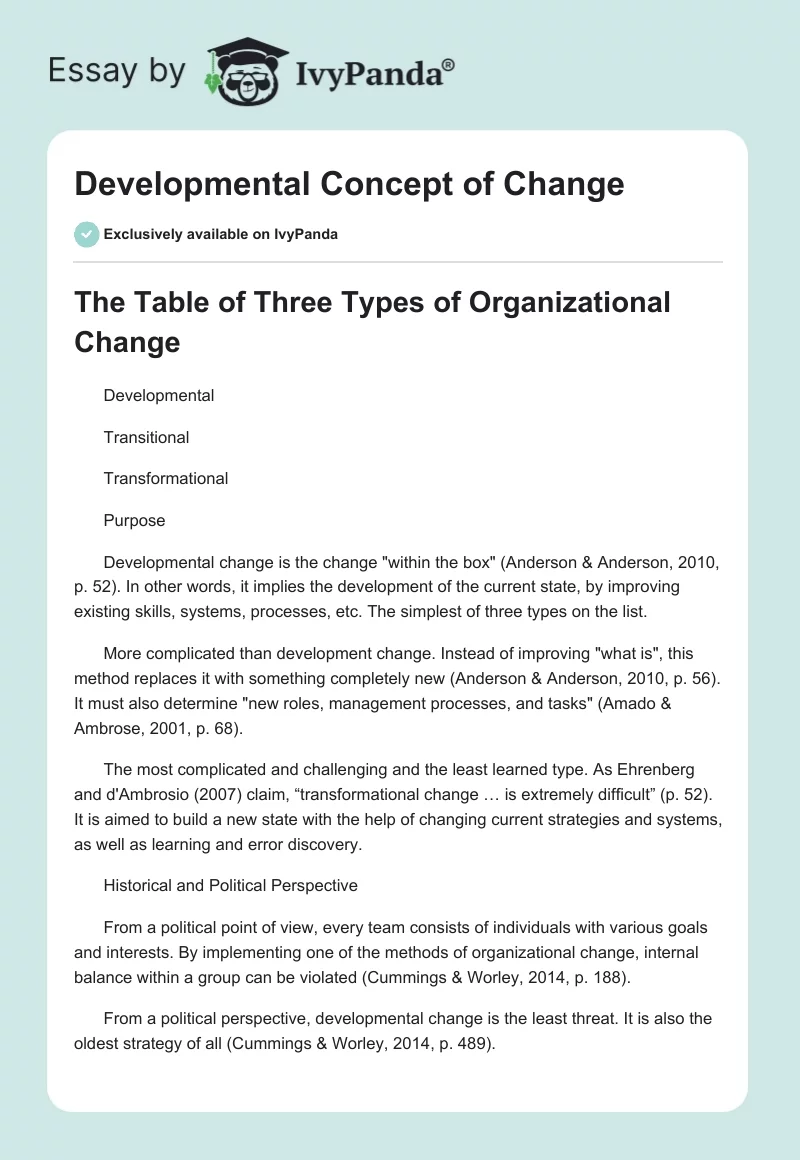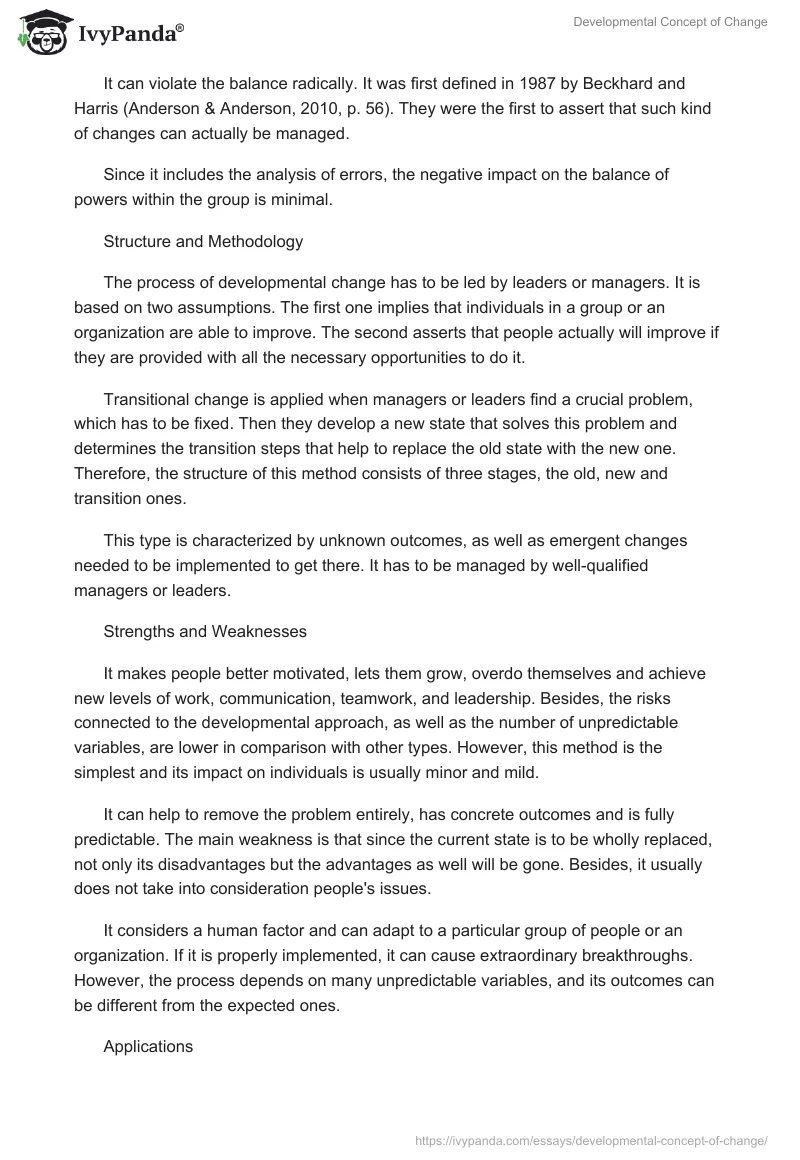The Table of Three Types of Organizational Change
The Literature Review of Developmental Concept of Change
Describing the developmental concept of change, this paper covers and examines several literature sources. A detailed critique and analysis are presented below. All comprehensive information about every source that has been used can be found in the reference list.
The Basic Method
The majority of sources describe the developmental method as the simplest one. Indeed, while the transitional type of organizational change implies creating an entirely new state as well as determining transitional levels and actions, which can help to achieve it, the developmental concept relies only on the current state. Unlike the transformational method that contains numerous unpredictable variables, the developmental type is much more linear. Even visually, if a person looks at the schemes of the organizational change types, the one that corresponds to the developmental approach seems to be really plain, especially in comparison with others (Anderson & Anderson, 2010, p. 53). Besides, as Cummings and Worley (2014) state, this type is also the oldest one. So, the developmental concept of change should be considered as the backbone of the rest.
The Cycle of Change
In her book, Helen Campbell (2014) defines the model of the Cycle of Change (p. 13). According to her words, it is “a simple representation of the diverse and complex task of changing an organization and is a handy way to look at the change in a holistic way” (Campbell, 2014, p. 14). The Cycle of Change illustrates what a group of people must have before the implementation of changes, what activities are to be involved and how they are connected, and, finally, who is responsible for every stage of the organizational change process. Unlike the transformational method, the developmental approach can be graphically represented according to the Cycle of Change and, thus, it can also be monitored at every stage. Besides, many particular activities and interventions needed to achieve the main goal are clearly determined from the very beginning. However, this method is still not entirely predictable (as the transitional type of change is) and does contain many variables, which depend on a situation.
Low Level of Uncertainty
Implementation of new strategies, especially the ones that are aimed to transform the whole organization of work, is always fraught with additional risks, mistakes, stresses and so on. Those usually appear as the result of the fear of change and unpredictability. In the article written by Bordia, Hobman, Jones, Gallois, and Callan (2004), the consequences of uncertainty in the frames of organizational change are described in detail. Because of the lack of control over the situation, the productivity of work, satisfaction, and trust in the common goal can vastly decrease. The lack of knowledge causes different types of errors and noticeably lower performance. Finally, all of these can easily bring anxiety, physical strain, and stress.
The developmental approach provides all the necessary conditions to avoid these adverse consequences. For example, communication and team-building help to reduce tension. Those also contribute to the exchange of knowledge and let the team members learn quicker. Additionally, the developmental concept of change implies practicing in problem-solving and monitoring the progress to prevent mistakes, as well as analyze those that have been already made. Finally, due to the proper feedback, all group members will feel valued and needed.
People-Oriented Approach
In comparison with the transitional approach, the developmental method is much more focused on a human factor and people’s desires. Aunola, Leskinen, Onatsu-Arvilommi, and Nurmi (2002) have conducted research, analyzing the response of more than a hundred first grade pupils (from six to seven years old) on new developmental changes. “Simultaneous use of variable- and person-oriented methods” in the developmental approach was the primary reason for its success (Aunola et al., 2002, p. 343). Still, the transformational type of organizational change is even more person-oriented.
So, there are numerous literature resources, which cover the topic of the developmental type of organizational change. Examining those, we can conclude that “developmental change is least threatening and easiest to manage” (Alas, 2014, p. 16). We can even say that this approach is the golden mean between two others. However, it can hardly lead to such exceptional breakthroughs, as the transformational approach does.
References
Alas, R. (2014). Implementation of Changes in Chinese Organizations: Groping a Way Through the Darkness. Oxford, UK: Chandos Publishing.
Amado, G., & Ambrose, A. (2001). The Transitional Approach to Change. London, UK: Karnac Books.
Anderson, D., & Anderson, L. A. (2010). Beyond Change Management: How to Achieve Breakthrough Results Through Conscious Change Leadership (2nd ed.). San Francisco, CA: John Wiley & Sons.
Aunola, K., Leskinen, E., Onatsu-Arvilommi, T., & Nurmi, J. (2002).Three Methods for Studying Developmental Change: A Case of Reading Skills and Self-concept. British Journal of Educational Psychology, 72, 343–364.
Bordia, P., Hobman, E., Jones, E., Gallois, C., & Callan, V. (2004). Uncertainty During Organizational Change: Types, Consequences, and Management Strategies. Journal of Business and Psychology, 18(4), 507-532.
Campbell, H. (2014). Managing Organizational Change: A Practical Toolkit for Leaders. London, UK: Kogan Page.
Cummings, T., & Worley, C. (2014). Organization Development and Change (10th ed.). Stamford, CT: Cengage Learning.
Ehrenberg, R. G., & d’Ambrosio, M. (2007). Transformational Change in Higher Education: Positioning Colleges and Universities for Future Success. Northampton, MA: Edward Elgar Publishing.


